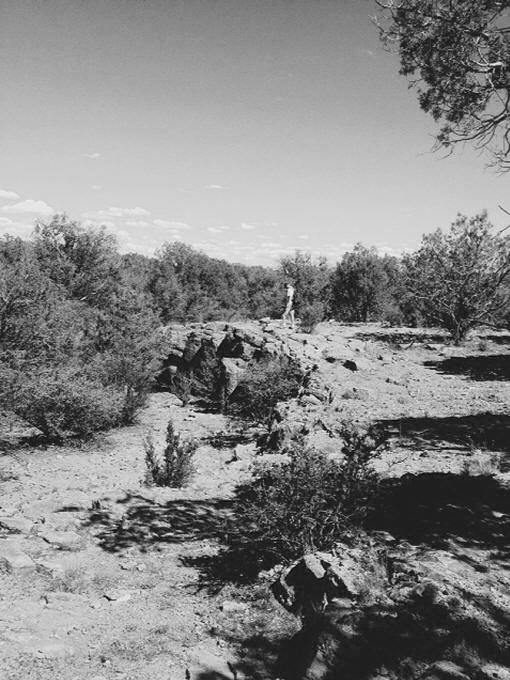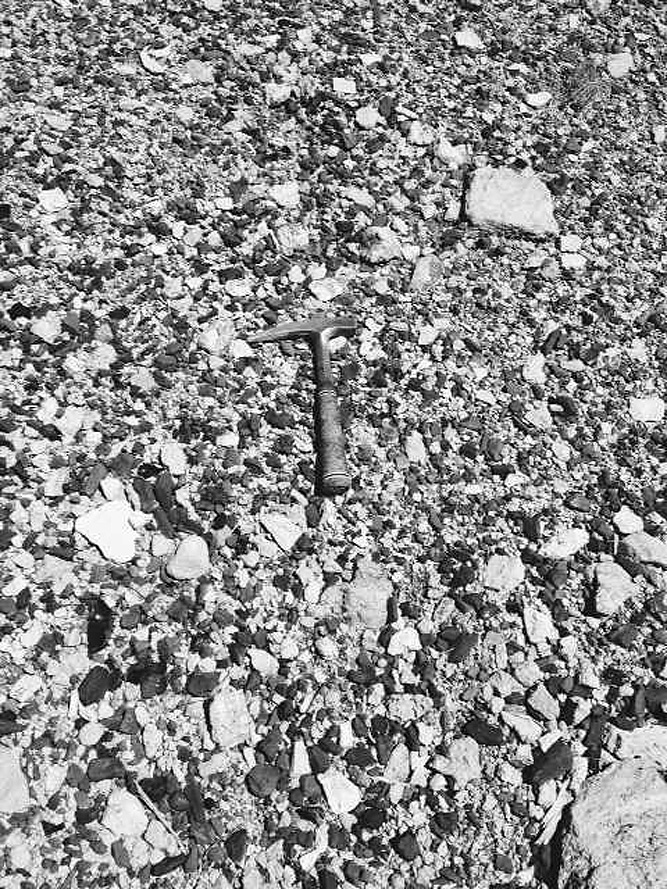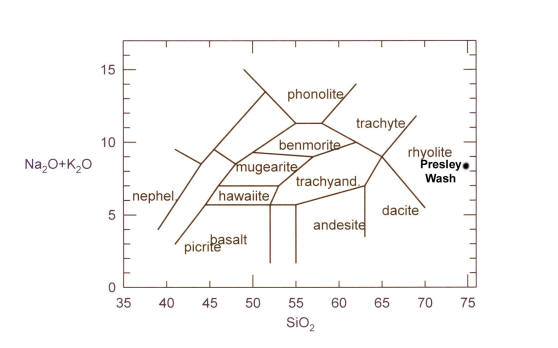MOUNT FLOYD VOLCANIC FIELD
OBSIDIAN SOURCES
NORTHERN ARIZONA
![]()
Partridge Creek (Round Mountain). Sections 28, 33, 34, R4W, T24N USGS Mount Floyd 7.5' Quad, southwest Coconino County, Arizona. There is some evidence that the source area may exhibit some chemical and megascopic variability, but the majority of the material appears to derive from the area described here (Jim Burton, Larry Lesko, and Dave Nealy: personal communication 1986). The primary source is located on the southeast flank of Round Mountain probably deriving from a number of rhyolite domes in the area (Bush 1985). The nodules are found in a rhyolite ash flow distributed mainly to the southeast of Round Mountain. The obsidian occurs as secondary deposits along Partridge Creek drainage for at least 15-20 km. Nodule sizes reach at least 16 cm in diameter, although most are near 10 cm. The highest nodule density can approach 10 per m2 (but see below). Cortex on the nodules varies from a thin gray-black to brown-black and tuff frequently covers many specimens. Red oxidized areas occur on the outside of some nodules. The aphyric interior approaches a very vitreous opaque black, but thin flakes exhibit a gray cloudy matrix. Cloudy banding infrequently occurs. The material is some of the best knapping obsidian of the large nodule varieties in Arizona, perhaps approached only by Government Mountain.
Prehistoric reduction of the material was common both at the source and along Partridge Creek. No high density reduction stations were noted in the 1980, but the material was probably 'test knapped' everywhere. A sandstone two-handed mano was the only other artifact type recorded.
updated August 2014: Surveyed around entire circumference of Round Mountain with Jeff Ferguson (U Missouri). While Round Mountain is a rhyolite dome complex, the vast majority of the archaeological obsidian is derived from a small dome on the south side of Round Mountain, probably vents off the main dome that quenched more rapidly. In August a very large obsidian/artifact pavement was discovered with 100s of cores and flakes per 5m2 within a geological pavement (see image below). Additionally, at or near the top of a portion of the small dome complex upslope from the obsidian pavement, perlitic lava exhibited in-situ obsidian, and a high density of nodules up to 10 cm in diameter, probably where the overlying obsidian zone has eroded southward (see image below). Analysis of a sample of the perlitic lava (080614-4-1) exhibits identical elemental composition and can be seen as part of the same eruptive event (see table below).
The first archaeological mention of this source was by Cameron and Sappington (1984), Lesko (1986) and Shackley (2005). Bush's (1985) recent geological study of the Round Mountain area was quite thorough (see also Moore, Wilson, and O'Haire 1960).
 Eroded perlitic lava at top of small dome on the south
slope of Round Mountain (August 2014, Jeff Ferguson for scale; samples
080614-4-n)
Eroded perlitic lava at top of small dome on the south
slope of Round Mountain (August 2014, Jeff Ferguson for scale; samples
080614-4-n)

Geological/artifact pavement downslope from above image (080614-1)
Elemental concentrations for Partridge Creek (Round Mountain) source standards including collections in August 2014 (080614-n). All measurements in parts per million (ppm).
| Locality/Sample | Mn | Fe | Zn | Rb | Sr | Y | Zr | Nb | Ba | Pb | Th |
| RM-1 | 513 | 8998 | 268 | 5 | 38 | 102 | 54 | 49 | |||
| RM-2 | 551 | 9115 | 265 | 6 | 39 | 97 | 54 | 46 | |||
| RM-3 | 485 | 8444 | 252 | 6 | 42 | 97 | 55 | 45 | |||
| RM-4 | 479 | 8379 | 250 | 6 | 38 | 95 | 54 | 46 | |||
| RM-5 | 466 | 8595 | 254 | 5 | 40 | 98 | 54 | 48 | |||
| RM-7 | 413 | 8085 | 244 | 5 | 38 | 95 | 54 | 44 | |||
| RM-8 | 519 | 8894 | 271 | 7 | 40 | 103 | 56 | 44 | |||
| RM-9 | 485 | 8623 | 256 | 6 | 38 | 98 | 58 | 46 | |||
| RM-10 | 480 | 8524 | 254 | 0 | 41 | 95 | 58 | 42 | |||
| RM-11 | 429 | 7986 | 242 | 6 | 38 | 93 | 56 | 47 | |||
| RM-12 | 449 | 8091 | 251 | 6 | 40 | 101 | 55 | 44 | |||
| RM-13 | 449 | 8106 | 241 | 8 | 37 | 95 | 51 | 44 | |||
| RM-14 | 515 | 9027 | 265 | 4 | 40 | 102 | 55 | 52 | |||
| RM-15 | 533 | 9118 | 276 | 7 | 40 | 102 | 54 | 46 | |||
| RM-16 | 491 | 8460 | 253 | 5 | 41 | 96 | 53 | 44 | |||
| 080614-1-1 | 482 | 9938 | 56 | 260 | 9 | 41 | 95 | 56 | 25 | 49 | 36 |
| 080614-1-2 | 467 | 9810 | 45 | 254 | 9 | 40 | 93 | 55 | 0 | 50 | 40 |
| 080614-1-3 | 424 | 9240 | 42 | 246 | 9 | 42 | 89 | 53 | 0 | 44 | 38 |
| 080614-1-4 | 497 | 9797 | 49 | 252 | 10 | 39 | 91 | 52 | 0 | 48 | 38 |
| 080614-1-5 | 471 | 9752 | 49 | 255 | 8 | 41 | 95 | 58 | 1 | 47 | 34 |
| 080614-2-1 | 404 | 9425 | 63 | 242 | 11 | 39 | 92 | 52 | 0 | 44 | 34 |
| 080614-2-2 | 451 | 9620 | 49 | 246 | 9 | 39 | 90 | 56 | 0 | 47 | 40 |
| 080414-2-3 | 385 | 8800 | 42 | 228 | 11 | 40 | 85 | 55 | 0 | 36 | 32 |
| 080614-2-4 | 444 | 9531 | 43 | 247 | 9 | 40 | 94 | 49 | 0 | 41 | 30 |
| 080614-4-1 | 422 | 8941 | 38 | 239 | 13 | 39 | 84 | 50 | 18 | 37 | 35 |
| 080614-4-2 | 429 | 9300 | 43 | 244 | 9 | 43 | 95 | 59 | 0 | 48 | 41 |
| 080614-4-3 | 432 | 9213 | 44 | 244 | 9 | 38 | 91 | 51 | 0 | 42 | 38 |
| 080614-4-4 | 397 | 8978 | 38 | 234 | 8 | 40 | 85 | 53 | 0 | 40 | 34 |
| 080614-4-5 | 447 | 9481 | 44 | 247 | 11 | 44 | 89 | 60 | 0 | 46 | 34 |
Mean and central tendency for the data in table above.

Oxide values for one sample of Round Mountain obsidian
|
Sample |
SiO2 |
Al2O3 |
CaO |
Fe2O3 |
K2O |
MgO |
MnO |
Na2O |
TiO2 |
|
Partridge Cr (Round Mountain) |
|
|
|
|
|
|
|
|
|
|
080614-4-5 |
77.15 |
12.288 |
0.4312 |
0.9034 |
4.715 |
<.001 |
0.0601 |
4.33 |
0.021 |
|
RGM1-S4 |
73.96 |
13.103 |
1.3888 |
2.181 |
4.823 |
<.001 |
0.0437 |
3.94 |
0.319 |
updated 1995: Two newly discovered sources of glass have been reported in the Mount Floyd Volcanic Field in association with the Partridge Creek locality west of the San Francisco Volcanic Field (Lesko 1989). Two new sources reported by Lesko (1989:389-390), have not been recognized in archaeological contexts outside northern Arizona, but were used prehistorically in that region (Lesko 1989).
Presley Wash.This is a gray and black glassy and sub-vitreous rhyolite most often opaque gray to gray-green to black. Sanidine phenocrysts (not quartz as stated by Lesko 1989:389) are uncommon to common in the matrix hampering control during knapping. The black variety is generally sub-vitreous, rarely with phenocrysts and not well suited to the production of small bifaces. There are no chemical differences between these two varieties and they occur together in Presley Wash east of Round Mountain. After the juncture of Partridge Creek running east from Round Mountain and Presley Wash, all varieties of obsidian are found in the alluvium (see Lesko 1989:389).
There has been some question as to whether the Presley Wash glasses are actually rhyolites. The EDXRF analysis of the major oxides however as shown in the table below indicates that it would be considered a high silica rhyolite. The Cox et al. alkali/silica plot graphically indicated the high silica rhyolite of Presley Wash. Evidently, the cooling rate and/or degassing was somewhat longer and slower than the Round Mountain glass.
updated August 2014: An additional collection along Presley Wash to the east of Round Mountain in August 2014 essentially exhibited the same results as the 1980s collections (samples 080614-5-n). Again, there is no statistically significant differences between the glassy gray-green samples and sub-vitreous black samples.
Raw elemental concentrations for Presley Wash source standards. All measurements in parts per million (ppm) B=black; GG-gray-green samples.
| SAMPLE | Ti | Mn | Fe | Zn | Rb | Sr | Y | Zr | Nb | Ba | Pb | Th |
| PWB | 1543 | 362 | 15342 | 92 | 194 | 15 | 141 | 23 | 1319 | |||
| PCD | 2557 | 421 | 19224 | 83 | 205 | 18 | 140 | 18 | 1262 | |||
| PCE | 1527 | 339 | 14257 | 93 | 187 | 16 | 138 | 22 | 1310 | |||
| PCF | 2234 | 382 | 18328 | 84 | 204 | 17 | 135 | 17 | 1324 | |||
| PW1 | 1562 | 354 | 15391 | 93 | 189 | 13 | 144 | 24 | 1400 | |||
| PW2 | 1681 | 351 | 15477 | 95 | 196 | 13 | 138 | 21 | 1294 | |||
| PW3 | 1886 | 398 | 17226 | 89 | 211 | 15 | 136 | 21 | 1401 | |||
| PW4 | 2856 | 432 | 21818 | 83 | 224 | 16 | 140 | 22 | 1250 | |||
| PW5 | 4672 | 557 | 30743 | 74 | 273 | 19 | 146 | 20 | 1107 | |||
| 080614-5-1B | 1702 | 314 | 14471 | 39 | 84 | 188 | 13 | 132 | 17 | 1497 | 24 | 16 |
| 080614-5-2B | 2411 | 364 | 18582 | 49 | 79 | 209 | 13 | 130 | 18 | 1339 | 17 | 16 |
| 080614-5-3GG | 1959 | 339 | 14692 | 65 | 89 | 191 | 17 | 136 | 23 | 1519 | 28 | 17 |
| 080614-5-4GG | 1831 | 322 | 14439 | 43 | 83 | 185 | 13 | 133 | 21 | 1486 | 21 | 20 |
| 080614-5-5B | 2849 | 413 | 21819 | 52 | 74 | 229 | 18 | 132 | 21 | 1372 | 17 | 19 |
| 080614-5-6GG | 1826 | 350 | 15025 | 44 | 88 | 189 | 11 | 133 | 22 | 1443 | 25 | 21 |
| 080614-5-7B | 3333 | 462 | 25322 | 62 | 76 | 257 | 15 | 144 | 22 | 1347 | 18 | 14 |
| 080614-5-8GG | 2210 | 441 | 17245 | 54 | 101 | 203 | 14 | 147 | 23 | 1701 | 29 | 24 |
Mean and central tendency for the data above.

THE MAJOR OXIDE ANALYSIS OF ONE SAMPLE OF THE GRAY-GREEN PRESLEY WASH GLASS AND THE RGM-1 USGS RHYOLITE STANDARD
|
Sample |
SiO2 |
Al2O3 |
CaO |
Fe2O3 |
K2O |
MgO |
MnO |
Na2O |
TiO2 |
|
Presley Wash |
|
|
|
|
|
|
|
|
|
|
PW-2-1 |
75.100 |
12.485 |
1.6251 |
1.7508 |
4.606 |
0.391 |
0.0402 |
3.62 |
0.228 |
|
RGM1-S4 |
75.680 |
12.477 |
1.3024 |
1.806 |
4.550 |
<.001 |
0.0379 |
3.77 |
0.196 |

The Cox et. al. (1979) alkali/silica plot for the Presley Wash sample above
Black Tank. I have not visited this source, but received samples from David Nealy (USGS, Flagstaff) in 1987. Lesko describes the source, also known as Rose Well obsidian, as located in the Black Tank area north of Round Mountain (1989:389-390). It occurs as small (<5cm diameter) black or black and mahogany nodules in an area disturbed by cattle tank construction. The black material is nearly identical megascopically to Partridge Creek glass, but exhibits a very different chemistry. Lesko describes the source as “small and the material not abundant” (1989:390). It rarely occurs in archaeological contexts even in northern Arizona.
Updated 9.30.23: An attempt to visit the Black Tank source in 24 September 2023 was stopped by a locked gate from the Diamond A Ranch even though it is on the Willaha Coconino Count road. Access is impossible at this time, according to the ranch hands at the Babbit Ranch. The four samples were reanalyzed on 9.30.23 as below.
Raw elemental concentrations for Black Tank source standards. All measurements in parts per million (ppm).
| Sample | Source Name | Location | Zone | Easting | Northing | Ti | Mn | Fe | Zn | Rb | Sr | Y | Zr | Nb | Ba | Ce | Pb | Th |
| BT1 | Black Tank | Mt. Floyd field, Coconino Co., AZ | 12 | 330740 | 3956740 | 1495 | 442 | 13615 | 49 | 114 | 118 | 16 | 99 | 30 | 1066 | 77 | 32 | 35 |
| BT2 | Black Tank | Mt. Floyd field, Coconino Co., AZ | 12 | 330740 | 3956740 | 1500 | 427 | 12897 | 44 | 128 | 120 | 20 | 94 | 27 | 931 | 44 | 26 | 27 |
| BT3 | Black Tank | Mt. Floyd field, Coconino Co., AZ | 12 | 330740 | 3956740 | 1351 | 406 | 11922 | 43 | 123 | 109 | 16 | 98 | 27 | 980 | 81 | 30 | 24 |
| BT4 | Black Tank | Mt. Floyd field, Coconino Co., AZ | 12 | 330740 | 3956740 | 1489 | 371 | 12201 | 42 | 110 | 129 | 20 | 98 | 32 | 1019 | 88 | 29 | 32 |
Mean and central tendency from data table above.
| Element | N | Minimum | Maximum | Mean | Std. Deviation |
| Ti | 4 | 1351 | 1500 | 1458.8 | 72.0 |
| Mn | 4 | 371 | 442 | 411.5 | 30.8 |
| Fe | 4 | 11922 | 13615 | 12658.8 | 758.0 |
| Zn | 4 | 42 | 49 | 44.5 | 3.1 |
| Rb | 4 | 110 | 128 | 118.8 | 8.2 |
| Sr | 4 | 109 | 129 | 119.0 | 8.2 |
| Y | 4 | 16 | 20 | 18.0 | 2.3 |
| Zr | 4 | 94 | 99 | 97.3 | 2.2 |
| Nb | 4 | 27 | 32 | 29.0 | 2.4 |
| Ba | 4 | 931 | 1066 | 999.0 | 57.4 |
| Ce | 4 | 44 | 88 | 72.5 | 19.5 |
| Pb | 4 | 26 | 32 | 29.3 | 2.5 |
| Th | 4 | 24 | 35 | 29.5 | 4.9 |
References Cited
Bush, Mark M., 1986, The Geology of Round Mountain, A Bimodal Volcanic Field in Northwest Arizona. Unpublished Master's Thesis, Department of Geology, State University of New York, Buffalo.
Cameron, Catherine M., and Robert L. Sappington, 1984, Obsidian Procurement at Chaco Canyon, A.D. 500-1200. In Recent Research on Chaco Prehistory, edited by W.J. Judge and J.D. Shelberg, pp. 153-160. Reports of the Chaco Center 8, Division of Cultural Research, National Park Service, Albuquerque.
Cox, K.G., Bell, J.D. and Pankhurst, R.J., 1979. The Interpretation of Igneous Rocks, Allen and Unwin, London. 450p.
Lesko, L., 1989, A Reexamination of Northern Arizona Obsidians. Kiva 54(4):385-399.
Moore, Richard T., Eldred D. Wilson, and Robert T. O'Haire, 1960, Geologic Map of Coconino County, Arizona. Bureau of Mines, University of Arizona, Tucson.
Shackley, M.S., 2005, Obsidian: Geology and Archaeology in the North American Southwest. University of Arizona Press, Tucson.
![]()
This page maintained by Steve Shackley (shackley@berkeley.edu).
Copyright © 2018 M. Steven Shackley. All rights reserved.
Revised: 30 September 2023
![]() Back to
the SW obsidian source page
Back to
the SW obsidian source page
![]()